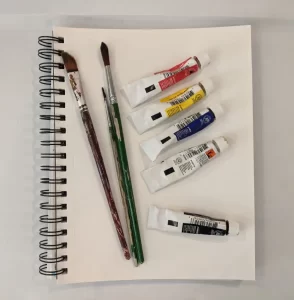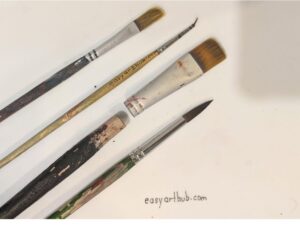Do you have a damaged acrylic paintbrush or two? No problem! This ultimate guide to acrylic paint brush care will revive, if not, transform them in no time. Get ready to paint some rocks with brushes that are good as new!
Revive damaged acrylic brushes by cleaning them with dish soap and hot water, and reshaping bristles with a rag. Use warm vinegar or rubbing alcohol to remove stubborn paint. Restore the bristle shape with a conditioner, fabric softener, or soap bar. Repurpose stiff brushes for detailing, stippling, dotting, and applying sealers or glue.
Reviving Damaged Paint Brushes
If you’ve found yourself in a bit of a pickle with your paint brushes—struggling with hardened acrylic paint or bristles that have lost their shape—don’t fret! I’ve got some nifty tips and tricks to bring them back to life.
~This post contains affiliate links.
Remove Hardened Acrylic Paint on Brushes
If you got some dried-up acrylic paint on the bristles of your brush, here are ways to remove them. This will work for most synthetic brushes.

Deep Clean with Dish Soap
Before attempting any of the methods below, it is important to deep clean your paintbrush with dish soap.
Follow these steps:
- Rinse your brush thoroughly as previously instructed.
- Apply a small amount of dish soap to the bristles.
- Gently massage the soap into the bristles with your fingers, taking care not to damage their shape.
- Rinse the brush with some hot water, holding it with the bristles facing down.
- While still warm and wet, reshape the bristles using a rag over your hand. Be careful not to touch the hot metal part with bare hands. Slide the bristles gently following the desired shape.
- Before storing your paintbrush, lay it on a dry rag to air dry or use a drying rack designed for storing paintbrushes with bristles facing down.
- Discard and rinse water properly.
In another blog post, I covered the “how” and “why” of proper acrylic rinse water disposal. You’ll need to see this to avoid clogging up your sink pipes.
Now, if the dish soap deep clean doesn’t completely do the trick, don’t panic. There are 2 more tricks to tackle that stubborn paint. Here are 2 using common household items:
Vinegar and Hot Water
If there is still some stubborn paint left after deep cleaning, swish the bristles in diluted warm vinegar (1 part vinegar, 1 part hot water) for 1 minute. Then rinse the bristles in the clean jar of water.
Note: Vinegar can dissolve the paint debris on the bristles. However, it can also damage the handle and glued parts of the brush, so try not to soak beyond the bristles.
Rubbing Alcohol
If vinegar doesn’t work, you can try rubbing alcohol. Just dip the bristles into a small amount of alcohol for a few seconds, and rinse as usual. Like with vinegar, do not soak beyond the bristles for too long as it can damage the other parts of the brush.
Note: Be careful with alcohol as it can quickly damage the wood finish/paint of the brush or your working area. It can also make your hands dry.
By following a few simple steps, you can make hardened brushes clean and restore their functionality.
From Splayed to Sleek: Reshaping Paint Brushes
But it’s not just about getting rid of the hardened paint. We also want to get those bristles back in tip-top shape. So, let’s tackle that too!
You see, over time, bristles can become misshapen or splayed out, making it quite the challenge to achieve the precision and control you need when painting. Fear not, though—I’ve got a few tricks to help you restore their form.
Brush Conditioner
There are also specialized brush conditioners available that can help to keep your brushes in top shape. These products typically contain ingredients that help to soften and condition the bristles, making them more pliable and less likely to become misshapen.
Hair Conditioner/ Matt clay
One household product to use is a hair conditioner or non-greasy matt clay. Apply a small amount of the product to the bristles of your brush, shape it, then let it soak overnight. Rinse the bristles thoroughly in the morning, reshape them, and let them air dry.
Fabric Softener
Another product that you can try to condition your paintbrushes is fabric softener. Simply dip the bristles for a few seconds. Rinse the brushes thoroughly with warm water, then reshape and dry them as I described before.
Soap Bar
A simple and effective way to clean your paintbrushes is to use a bar of soap. Simply rub the wet bristles gently against the soap, carefully shaping the bristles. Leave it to dry for 4 to 12 hours. Rinse, shape, and dry as usual.
By employing these techniques, you can transform splayed brushes into sleek tools to enhance your painting experience.
Don’t Toss Them Yet! Saving Stiff Paint Brushes
If nothing works and you still have a stiff brush, don’t throw them out just yet. By repurposing your old synthetic brushes, you can save money and reduce waste. Here are some ways you can repurpose your old synthetic brushes:

Detailing brush
One option is to cut some of the bristles to create a thinner tip, which can be used for detail work. This is especially useful if you need to paint small areas or add fine lines. This is a great tool for rock painting because they are much smaller than typical painting surfaces.
In the picture above, I used an old damaged liner brush. Trimmed most of the bristles including the stray ones, then used it to paint very fine details on my rock art.
Stippler brush
You can also trim the tip of your old brush and use it as a stippling brush. Stippling brushes are great for creating textures and adding depth to your rock paintings.
Dotting tool
One more way to repurpose your old brush is to use the handle as a dotting tool. This can be great for creating small dots or adding texture to your paintings.
If you have a brush with a detached ferrule (the metal part) you can even create 2 dot sizes with that.
Brush-on sealer
You can also use your old brush to apply the brush-on sealer. Sealing is a great way to protect your rock paintings and make them last longer.
Applying glue
Finally, you can repurpose your old brush to apply glue. This can be especially useful if you’re working on a mixed-media project or need to glue something in place.
Taking care of your damaged acrylic paint brushes doesn’t have to be a big hassle. With the helpful techniques and tips shared in this ultimate guide, you’ll be able to bring your brushes back to life in no time. Happy painting!



